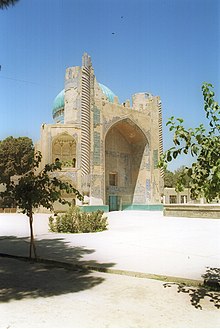Rabia Balkhi

Rabia Balkhi, also known as Rabia al-Quzdari (or Khuzdari)[a] was a 10th-century writer who composed poetry in Persian and Arabic. She is the first known female poet to write in Persian.
A non-mystic poet, her imagery was later transformed into that of a mystic poet by authors such as Attar of Nishapur (died 1221) and Jami (died 1492). She became a semi-legendary figure, famous for her love story with the slave Bektash.
Her shrine is located in the mausoleum of the 15th-century Naqshbandi Sufi Khwaja Abu Nasr Parsa (died 1460) in the city of Balkh, now present-day Afghanistan. She is celebrated in the Balochistan province of Pakistan, Afghanistan and Iran through various schools, hospitals, and roads being named after her.
Background
She is known by various names, Rabia Balkhi, Rabia al-Quzdar (or Khuzdari), and anonymously as a "daughter of Ka'b". Most of her life is considered to be obscure.
Biography
Rabia lived during the same period as the poet
Rabia appears in the
A romanticized version of this story appears in the Ilahi-nama of the Sufi poet Attar of Nishapur (died 1221), under a story named Hikayat Amir-i Balkh wa ashiq shudan dukhtar-i o ("the story of the chieftain of Balkh and his daughter's falling in love"). The story narrates Rabia's love affair with Bektash, a slave of her brother Haris, and concludes with the death of both Rabia and Bektash. Attar does not use the name "Rabia" either when referring to her, and instead calls her Zainu'l Arab ("the ornament of the Arabs"). He reports that she was so attractive that it was almost impossible to describe her beauty. Francois de Blois dismisses Attar's story, considering it to have "no value as a biographical source" for Rabia.[7]
The modern historian Sunil Sharma notes that Rabia initially started out as non-mystic figure, being portrayed by Awfi as a "boy-chasing intelligent woman", and was only later portrayed as a mystic poet by authors such as Attar and Jami.[3] Dabashi notes that Rabia later became a "semi-legendary figure who putatively wrote her last poems with her blood on the prison walls of the jail in which she had been incarcerated because of her love for a slave named Bektash."[8] Her love story with Bektash encouraged the 19th-century writer Reza-Qoli Khan Hedayat (died 1871) to write the romantic epic of Golestan-e Eram or Bektash-nama, which tells the story of the two pairs.[9][10]
Rabia's shrine is located in the mausoleum of the 15th-century Naqshbandi Sufi Khwaja Abu Nasr Parsa (died 1460) in the city of Balkh, now present-day Afghanistan.[11] The shrine was renovated between 2012 and 2016.[12] She is celebrated in the Balochistan province of Pakistan, Afghanistan and Iran through various schools, hospitals, and roads being named after her. Women consider her to serve as a replacement for their lost voice. The 1974 Afghan film Rabia of Balkh not only played a central role in the cinema of the country, but according to Krista Geneviéve Lynes "also in the figuration of a proto-feminist political agency, one that in many respects resembles the ethnical call for justice in Sophocles's Antigone."[11]
Notes
References
- ^ a b c d Aftab 2022, p. 205.
- ^ a b c Dabashi 2012, p. 89.
- ^ a b Sharma 2009, p. 151.
- ^ Aftab 2022, pp. 206–207.
- ^ Dabashi 2012, p. 90.
- ^ Blois 2004, p. 189.
- ^ a b Aftab 2022, p. 206.
- ^ Dabashi 2012, pp. 89–90.
- ^ Losensky 2003, pp. 119–121.
- ^ Rypka 1968, p. 144.
- ^ a b Aftab 2022, p. 207.
- ^ Khwaja Parsa Complex Conservation.
Sources
- Aftab, Tahera (2022). Sufi Women of South Asia: Veiled Friends of God. Brill. ISBN 978-9004467170.
- Blois, Francois de (2004). Persian Literature - A Bio-Bibliographical Survey: Poetry of the Pre-Mongol Period (Volume V). Routledge. ISBN 978-0947593476.
- ISBN 978-0-674-06759-2.
- "Khwaja Parsa Complex Conservation". archnet.org. Retrieved 30 October 2022.
- Losensky, Paul E. (2003). "Hedayat, Reżāqoli Khan". In ISBN 978-0-933273-75-7.
- ISBN 978-9401034814.
- Sharma, Sunil (2009). "From ʿĀʾesha to Nur Jahān: The Shaping of a Classical Persian Poetic Canon of Women". Journal of Persianate Studies (2). .
Further reading
- Havlioglu, Didem (2017). Mihrî Hatun: Performance, Gender-Bending, and Subversion in Ottoman Intellectual History. Syracuse University Press. ISBN 978-0815635376.
- Hillmann, Michael Craig (2022). "Use of Translations of Classic Persian Poems in the Study of Persian". The Routledge Handbook of Persian Literary Translation. Routledge. pp. 334–385. ISBN 978-0367510411.
